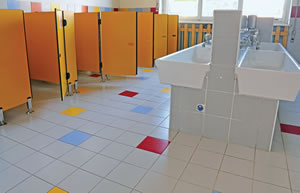Wellness Policies and Restrooms

PHOTO © CHICCODODIFC
We need to rewrite Tina Turner’s song,
“What’s love got to do, got to do with it.”
For this article we need to ask, “What’s the
wellness law got to do, got to do with kids?”
To start with, every school district in the
United States is required by Public Law 111-296, passed Dec. 10, 2010, to have a local
school wellness policy.
In fact, a 2004 law required local education
authorities, another name for school
districts, to have school wellness policies
by July 1, 2006. Most districts complied in
a minimal way.
However, since Aug. 29, 2016, approved
federal regulations now go along with the
more comprehensive 2010 school wellness
policy requirements.
Thus, as a result of the 2004 law, the 2010
law and the 2016 rules, there is a framework
to establish healthy school environments in
the approximately 13,500 districts affecting
about 50 million students in more than
98,000 school buildings.
The guidelines, in the form of a statute
and a rule, have everything to do with the
wellness of students in every school district
in the nation.
However, too many local education authorities
have looked at the requirements for
better nutrition and more physical activity
and considered the requirements as an unfunded
federal mandate. Too many policies
are too wordy, too brief or too vague.
Rather than judge the policies, which like
a two-legged stilt stress just two activities —
nutrition and physical, — a better approach is
to connect wellness policies with eating better
(nutrition) exercising more (physical activity)
and eliminating properly (sanitation).
By having three Es — eat, exercise, eliminate
— we have a three-legged stool. We have
brought a taboo subject — school toiletry —
to the wellness table.
What's wellness got to do, got to
do with school restrooms?
The two public laws, in 2004 and 2010,
required local school wellness policies to include
at a minimum three goals: (a) nutrition
promotion and education; (b) physical activity;
and (c) other school-based activities.

PHOTO © GOODLUZ
These goals were to promote student
health and reduce childhood obesity. The
one that is overlooked, though it is equally important, is “other school-based activities.”
School districts know their students,
their constituents’ health and their local culture.
The Federal rule effective August 2016,
after six years of having Public Law 111-296
on the books, requires specific goals to be
determined locally, with some consideration
of research and evidence-based strategies,
as well as adhering to several food, beverage
and nutrition standards.
“Other school-based activities” that
promote student wellness can certainly
include safe, clean and hygienic restrooms.
Consider schools all have cafeterias,
and these lunch or breakfast rooms are
really the “restaurants” for their patrons,
the students. The same students are like
customers who go to a food chain or upscale
location for lunch. They need to wash
their hands before eating. After lunch these
same patrons may need to use the toilet and
require tissue, soap and towels.
Therefore the students’ behavior before
and after meals is directly tied in with
whether the food is provided by the Richard
B. Russell National School Lunch Act, in a
sack, or in a homemade food container.
Wellness policies have several requirements,
so linking eating and eliminating
is like having fruit and vegetables on the
new nutrition plate or within the old food
pyramid.
Local school wellness policies also have
several public awareness and participation
requirements.
For example, the school system must
identify the position title of a district or
school official(s) who has the duty to implement
the wellness policy.
What's the district official got to do,
got to do with the wellness policy
including healthy restrooms?
Who is that person? What is his or her
phone number and email?
Although one individual alone does not
usually have authority over all aspects of
nutrition, physical and other school-based
areas, the Federal law and rule also require
eight categories of individuals to be part of
the development, implementation, review
and update of these wellness policies.
Students, parents, board members and
the public must be permitted to participate
in the preparing, accomplishing, reconsidering
and renewing these policies. Four educational
professionals must be permitted
to carry out the same four functions.
Records must be kept of these community
involvement requirements, which an
official in the state Departments of Education
will review every three years.
Each school will have to have local wellness
activities, which comply with the district’s
school wellness policy, which will be
checked for compliance in these triennial
assessments.
Consider the partnerships medical associations,
community health coalitions,
personal trainers and etiquette specialists
could develop with schools to promote
wellness. Best practice partnerships that
promote student health and reduce childhood
obesity are basic to wellness.
Since every student breathes, eats,
drinks, sleeps and poops, we educators
need to renew one of our favorite slogans:
“We are doing it for the boys and girls.”
So what’s love got to do with the law,
What’s the law got to do with wellness,
What’s wellness got to do with restrooms,
What’s wellness policy got to do with a
responsible person,
What’s a wellness committee got to do
with wellness requirements,
What’s love of kids got to do, got to do
with it?>
EVERYTHING!
This article originally appeared in the issue of .
About the Author
Tom Keating, Ph.D., has advocated for improved restrooms for students since 1994. He is coordinator of Project CLEAN and founder of the Center for Sanitation and Citizenship. He can be reached at 404/694-2905 or [email protected]. The "Publications" and "Video" links at www.projectclean.us have numerous articles and materials on restroom issues. One article, "We Need to See the Third 'E'" is also about wellness.